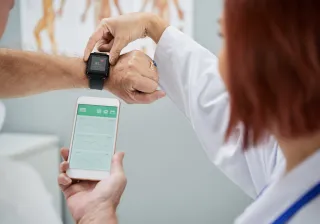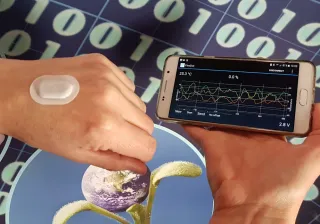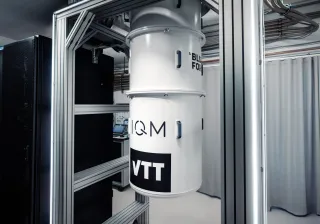An aging population, cardiovascular diseases and mental disorders are significant challenges that society is facing today. Some of these challenges can be addressed by wearable human sensing technologies and data analysis, which enable the early detection of health issues that might go unnoticed in daily routines. Teemu Ahmaniemi, VTT's leading expert in human sensing solutions, unveils what integrated sensing technologies can offer us in our everyday lives.
Read the summary
- Multimodal data integration allows for a comprehensive understanding of an individual's health by combining various sensor data, offering more complete health assessments and improved diagnostics.
- The technology is applicable beyond healthcare, aiding in sports performance, stress and cognitive monitoring, and can be integrated into everyday environments to provide insights that enhance safety and overall wellbeing.
- VTT has a strong expertise in both health data analytics and device design for sensing solutions.
This summary is written by AI and checked by a human.
As society faces the challenges of an aging population, increasing cognitive disorders and declining mental wellbeing, there is a growing need for effective solutions. Human sensing technologies offer promising tools for early detection of health conditions. By using advanced sensors and data analysis, these technologies can help identify health issues early, allowing for timely care and support.
Currently, several simultaneous measurements that offer an accurate indication of an individual's mental and physical state are typically possible only in hospital settings. However, the miniaturisation of electronics, coupled with reduced power consumption and improved data transfer, has made it possible to implement these capabilities within home environments, as well as in outdoor and mobile contexts, thereby enabling continuous health monitoring.
New human sensing solutions enable multimodal data and continuous monitoring
Thanks to these advancements in technology, data can now be collected over longer periods, from multiple sensors.
“Now we can combine several modalities, such as the data from an ECG based heart rate monitor with eye movements and optical pulse tracking to gain a much more comprehensive and accurate understanding of a person’s state,” explains Teemu Ahmaniemi, human sensing solutions Research Team Lead at VTT.
Multimodal data is already available in a hospital setting, where multiple sensors facilitate holistic analysis. However, these measurements are limited to short time periods, often capturing data only during certain moments, such as a hospital visit. A specific disorder, such as an arrhythmia or an apnoea episode, may occur at different times and may therefore be missed.
“Continuous measurement provides greater value and offers a more complete picture of health, adding a new dimension to the assessment of diseases and health conditions,” says Ahmaniemi.
Miniaturised, affordable electronics not only facilitate health monitoring in home environments but also offer solutions for healthcare in developing countries. Wearable, easily transferable technology can be adopted in resource-limited environments, improving access to healthcare.
Measure everything from cardiovascular health to cognition and stress
The use of multiple sensors enables the measurement of a wide range of critical variables.
To gain a comprehensive understanding of the heart and circulatory system's performance, we can analyse how the heart beats through electrocardiography (ECG) and assess valve function with phonocardiography (PCG). Furthermore, we can measure blood flow optically by assessing the absorption of light in blood vessels just beneath the skin's surface (PPG).
Support for diagnosing and monitoring diseases is just one of the many use cases that can benefit from human sensing solutions. When applied to sports performance or demanding work environments, we can also measure factors such as stress, cognitive function and workload. These insights can then be used to enhance safety and improve overall work performance and wellbeing.
“In simulated environments, such as virtual reality, we can identify which types of conditions generate high workload and which are more relaxing. This way, we can provide tools to control the workload,” Ahmaniemi explains. “We can develop, for instance, personalized training protocols tailored to individual needs.”
Vision for the future: Integrating sensing technologies into everyday environments
As measuring instruments continue to shrink in size, they will likely become more ingrained in our everyday lives and environments over the next ten years, believes Ahmaniemi. These devices will be capable of capturing a wide array of physiological and environmental metrics, providing us with unprecedented insights into human health and activity.
“With human sensing solutions, early-stage diseases could be detected sooner, offering reliable and straightforward answers to common concerns about whether one has a disease or what a particular symptom might indicate,” Ahmaniemi explains.
The big question is: how is this achieved? Will we agree to being measured? Will measuring devices be integrated into homes, such as sensors embedded in floors or furniture? Could they be incorporated into everyday items like desk chairs, computer mice or mobile phones?
“For example, we can detect early signs of memory lapses by analysing speech. Now, if a phone were to monitor your speech patterns, it could identify when you struggle to find words, indicating possible memory issues,” Ahmaniemi envisions.
He also believes that in the future, smart devices and wearable technology will become increasingly prevalent. Just as rings and smartwatches provide health insights today, similar intelligent technologies could be integrated into everyday items like socks, hats or eyewear in the future.
“Early detection of health conditions not only enhances individuals' prognoses but also strengthens the resilience of our healthcare systems,” says Ahmaniemi.
VTT offers unique combination of expertise in health data analytics and device design
VTT has decades of expertise in measuring and analysing physiological signals and biomarkers and interpreting the human state.
“We have a profound understanding of human physiology and psychophysiology, which enables us to identify the specific provocations or stimuli needed to effectively and safely elevate blood pressure or increase cognitive load,” says Ahmaniemi.
“Furthermore, we know how to process the raw data to find clinically relevant and valuable information.”
VTT is also a trailblazer in the development of measurement electronics. The technical research centre’s strengths lie in sensing solutions, ranging from wearable sensors for physiological and biochemical measurements to remote sensing of health and behaviour in smart spaces.








